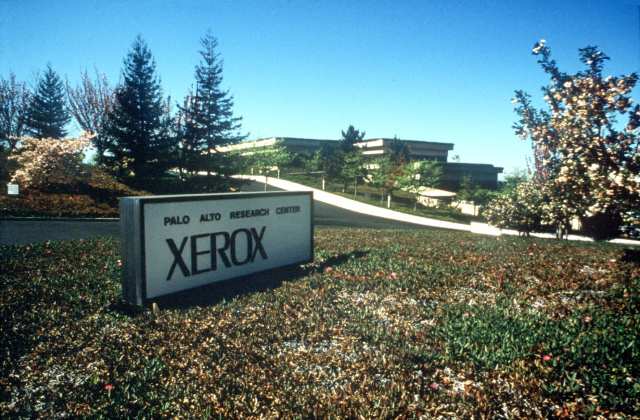Which is more important – efficiency or compliance?
To help position the relevance of the question above, perhaps let's start with a short explanation of the genesis of Document Automation (also called Document Generation).
Most people think that current Document Automation applications started with the legal profession, where in the late 90s lawyers' secretaries used templates to create basic legal documents.
In fact, for the true genesis you need to go further back – to the early 70s in the Silicon Valley, and the Xerox PARC research facility in Palo Alto. Here were the true beginnings of Document Automation.

Xerox PARC in 1996. Credit: Xerox
In those days, speed and efficiency were the rationale. It used to take insurance underwriting assistants perhaps an hour or two to manually assemble an insurance policy with endorsements. They used a filing cabinet with coded paper endorsements inside.
Xerox PARC designed software to drive their large printers, principally for the insurance and banking markets. Using the new "collating" software, a printer could produce and staple the same policy in minutes. It saved companies hours by replacing manual effors with machines.
This technology endures today under the guise of Customer Communication Management applications. Many of these are amalgams of disparate applications acquired over time, and made to look pretty with a nice front end.
CCM's genesis from this era means that these applications are very capable feature and function-wise; however, they are still mostly reliant on IT developers to "code" the templates. This dependence makes changes both time-consuming and slow to implement, depending on the availability of valuable IT development resources.
This creates a "time to market" challenge for agile corporations, where speed is of the essence in a changing and competitive marketplace.
The cry of most, if not all, Document Automation vendors is still based on speed and efficiency, as well as the resultant return on investment (ROI).
A simple calculation based on FTEs (Full Time Equivalent) ability to become more productive, and therefore reduce costs, is used to justify the implementation of this technology. Employees can be far more productive by using automation in their daily tasks.
While this is important, especially when producing a business case for the CFO, the reality of why automation applications are gaining traction is something far more important to clients.
With the world becoming more regulated, ensuring accuracy and compliance of whatever information you are providing to your clients is of paramount importance.
This was confirmed to me by the CIO of a large US insurer during a meeting in 2010.
I was sure that the improved efficiency gained from using our application was of significant benefit to her company. She agreed – but stated that this was not the primary reason they chose ActiveDocs.
For her it was ensuring that the documents sent out were correct, and the fact that because we enforced rules and logic, we removed human error. Any flaw in the policy document could result in millions of dollars of liabilities or fines. Our application meant they could be confident that all their policies were correct.

In the last nine years, regulatory compliance has gained worldwide traction. It started with the Sarbanes-Oxley Act of 2002, and grew in significance following the GFC worldwide. It is now the primary reason why clients choose to deploy Document Automation applications.
Regardless of market segmentation, the issue of compliance is applicable to every business.
The use of automated document production (ADP – or more commonly, application to application publishing) removes human error, and provides the ability to update a regulatory change across thousands of templates instantly. It makes businesses more agile and adaptable to the constantly changing regulatory landscape which defines the world we currently live in.
Today, corporations can face significant fines for non-compliance, not to mention that Senior Executives can, in some cases, be imprisoned if found to be knowingly negligent. This makes compliance a far more significant driver for change than efficiency.




